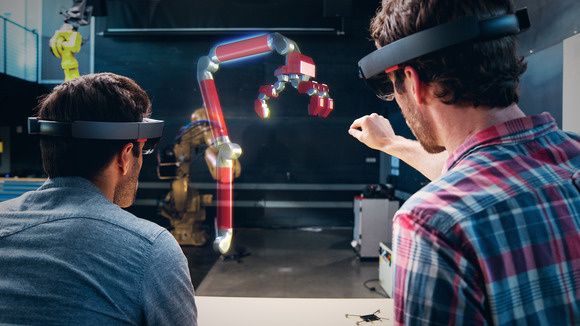Intended for broadcast journalists, this broadcast-quality footage highlights Microsoft HoloLens. Microsoft HoloLens is the world’s first fully untethered holographic computer, powered by Windows 10, enabling high-definition holograms to integrate with your world.
Category: augmented reality – Page 68

Technology Will Save Our Future, According To Japanese SF Author Taiyo Fujii
I’ve been increasingly interested in translated science fiction novels, and one of the best ones that I picked up this year was Taiyo Fujii’s debut Gene Mapper.
Gene Mapper takes place in a future where augmented reality and genetic engineering is commonplace. When a freelance gene mapper named Hayashida finds that a project that he had worked on is collapsing, he believes that it’s being sabotaged. Determined to fix it, he travels to Vietnam where he finds that there’s more behind the problem than he initially thought.
You can read a tie-in story over on Lightspeed Magazine, ‘Violation of the TrueNet Security Act’.

Autodesk will bring digital designs into the real world with Microsoft’s HoloLens
Autodesk and Microsoft have teamed up to bring virtual product designs into the real world using augmented reality. The two companies announced on Monday that Autodesk Fusion 360 — software that lets users design, test, and ultimately manufacture physical objects — will connect with Microsoft’s HoloLens headset.
Right now, details about the final product are scarce, but the two companies have spent time working together over the past year on bringing 3D models from a screen to the real world by displaying them to users wearing the HoloLens. The collaboration could make it possible for designers working in Fusion to work together on digital models in the physical world, if everyone involved is wearing one of Microsoft’s augmented reality headsets.
Doing that has the potential to be a boon for product designers, since they wouldn’t have to spend as much time manufacturing physical prototypes to be able to see how a product could look in real life. The HoloLens likely won’t replace physical prototyping entirely, though: the device’s field of view is fairly limited at this point, which means that it could be hard for designers to get a full feeling of what an some objects would look like, especially if they’re particularly large.
Amazon wants augmented reality to be headset-free
Augmented reality (AR) isn’t all headsets and funny glasses. Amazon wants to turn it into something that you can interact with in your living room, judging by a couple of the company’s recently approved patents. The “object tracking” patent shows how a system of projectors and cameras could beam virtual images onto real objects, and track your hand while you interact with them. The other, called “reflector-based depth mapping,” would use a projector to transform your room into a kind of holodeck, mapping the depth of objects and bodies in a room.
If all of this sounds familiar, it certainly is — Microsoft has a very similar concept called “RoomAlive” (originally “IllumiRoom”) that used a combination of projectors and Kinect depth sensors to turn your room into a virtual environment (below). In demos, Microsoft showed how the system could generate a virtual room that would enhance videos and even let you interact with /shoot at game objects projected on your walls. Microsoft appears to have put the RoomAlive concept on the backburner for now (though you can try to hack one together yourself) while it focuses on its Hololens headset-based AR concept.
How Microsoft’s HoloLens May Change Everything For Industrial And Mechanical Designers
By integrating Microsoft’s “mixed reality” system and Autodesk’s Fusion 360 design software, designers can see 3D holograms of their work.

Google Glass Successor Dumps Some Glass — By Jessica E. Lessin | The Information
“We’ve learned that Google’s revamped Google Glass project, dubbed Project Aura, is working on a wearable with a screen—and at least one without.”
Volvo teams with Microsoft HoloLens for virtual car buying
In the near future, car buyers may find themselves putting on Microsoft’s HoloLens augmented reality headset in order to check out a Volvo in a kind of virtual showroom. The car manufacturer has announced a partnership with Microsoft to incorporate the HoloLens into the car buying experience. The concept they debuted today images a customer and car dealer putting on the headset and interacting with a holographic car.
The HoloLens would allow users to do the typical things one would expect when shopping for a car, like comparing colors and wheel rims, as well as much more, like inspecting a projection of the engine from any angle, getting a view of what it’s like to sit inside, or experience demonstrations of a car’s unique features.

Asus says it’s building an augmented reality headset to release in 2016
Taiwanese PC manufacturer Asus says it’s building an augmented reality device and aims to release it next year. According to a report from CNET, Asus CEO Jerry Shen confirmed the plans during an earnings call on Wednesday, arguing that augmented reality or AR will be more useful than virtual reality. “You can make a real setting meld together with yourself and the AR portion,” said Shen. “Internally, we are talking about how to prepare.”
Unlike VR, augmented reality doesn’t show you a completely fabricated view, but instead overlays digital elements onto the real world. The current frontrunner in this nascent field is Microsoft’s HoloLens, which the company has shown off in a range of impressive demos. However, the HoloLens is hampered by a number of problems, including bulkiness, constrained viewing angles, and a high price tag, with Microsoft releasing a $3,000 HoloLens developer kit in the first quarter of 2016. (By comparison, Samsung’s Gear VR, a virtual reality headset powered by the company’s smartphones, became available for preorder this week for just $99.) Asus has previously hinted that it might build its own version of the HoloLens, but as a company best known for its budget laptops, tablets, and smartphones, we wouldn’t expect it to match Microsoft’s price.
Despite the lack of unknowns surrounding Asus’s announcement, it’s still interesting to see a company align itself with augmented, rather than virtual, reality. The Verge’s Adi Robertson has argued that the complete immersion of VR makes it difficult for multitasking, and that augmented reality, by comparison, is more practical. Asus apparently agrees. “We think AR will be very important for people’s lives,” said Shen according to CNET. “It should be next year when we come out with a product.”
Humans will be able to use augmented intelligence to compete with robots
In January this year Microsoft announced the HoloLens, a technology based on virtual and augmented reality (AR).
HoloLens supplements what you see with overlaid 3D images. It also uses artificial intelligence (AI) to generate relevant information depending on the situation the wearer is in. The information is then augmented to your normal vision using virtual reality (VR).
A Whole New World: Disney App Renders Coloring Book Pages as 3D Images — By Lulu Chang | Digital Trends
“Who said coloring was just for kids?”